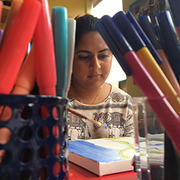
The Incubator welcomed Smita Bhattacharya, MS, for a week-long art immersion residency in mid-August. Bhattacharya is a recent graduate of Johns Hopkins University, where she studied biotechnology through the lens of public health and neuroscience. Prior to graduate school, Smita coordinated learning and research activities for the Pediatric Integrated Care Collaborative (PICC), a SAMHSA-funded learning collaborative for primary care practitioners seeking to increase access to behavioral health services for children. She also worked on issues of substance use, mental health, and maternal/child health as a NIH-National Institute on Drug Abuse (NIDA) fellow at Yale University.
So how does a biotechnologist with a passion for behavioral health end up as an “Artist-in-Residence”? Bhattacharya is an avid artist, specializing in oil painting, and has leveraged her artistic experience to collaborate with communities in Ghana and Kerala, India.
“Art is a medium that encourages genuine collaboration and cross-cultural exchange about difficult topics, like mental health,” remarked Bhattacharya, while snipping images and text for a collage examining food insecurity. She moved and layered the images on the page, pausing to weigh the implications of the arrangement. Her collage was a prototype for a series of art activities designed to facilitate reflection around introductory global health topics in the classroom.
Bhattacharya used her immersion week to integrate her interests in art, education, and public health, focusing on visual learning tools to scaffold and supplement the Incubator’s ongoing work at this intersection. Smita began each morning with an energetic, rapid-fire brainstorm with Faculty Director Sue J. Goldie—known for her experimentation with drawing and visual communication—before developing film experiments, classroom activities, and prototypes alongside GHELI’s pedagogy and multimedia staff.
Working with Multimedia Administrative Coordinator Camilla Finlay, Bhattacharya designed and filmed an artistic project using henna, a natural dye used in social and holiday celebrations in many South Asian countries. Bhattacharya used the medium of henna to visually represent cardiovascular health in the South Asian community. Cardiovascular disease is the leading cause of death globally, and the piece invited dialogue and exploration about the rising rates of this disease in South Asia.
“I studied biotechnology to think more deeply about innovation in health care,” said Bhattacharya. “My time at the Incubator has allowed me to further explore the ways art and film can achieve this aim, equitably and sustainably.”
